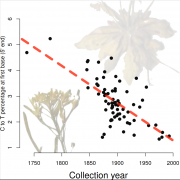Temporal patterns of damage and decay of DNA from herbaria specimens
Temporal patterns of damage and decay kinetics of DNA retrieved from plant herbarium specimens
Herbaria archive a record of changes of worldwide plant biodiversity harbouring millions of specimens that contain DNA suitable for genome sequencing. To profit from this resource, it is fundamental to understand in detail the process of DNA degradation in herbarium specimens. We investigated patterns of DNA fragmentation and nucleotide misincorporation by analysing 86 herbarium samples spanning the last 300 years using Illumina shotgun sequencing. We found an exponential decay relationship between DNA fragmentation and time, and estimated a per nucleotide fragmentation rate of 1.66×10-4 per year, which is six times faster than the rate estimated for ancient bones. Additionally, we found that strand breaks occur specially before purines, and that depurination-driven DNA breakage occurs constantly through time and can to a great extent explain decreasing fragment length over time. Similar to what has been found analysing ancient DNA from bones, we found a strong correlation between the deamination-driven accumulation of cytosine to thymine substitutions and time, which reinforces the importance of substitution patterns to authenticate the ancient/historical nature of DNA fragments. Accurate estimations of DNA degradation through time will allow informed decisions about laboratory and computational procedures to take advantage of the vast collection of worldwide herbarium specimens.



